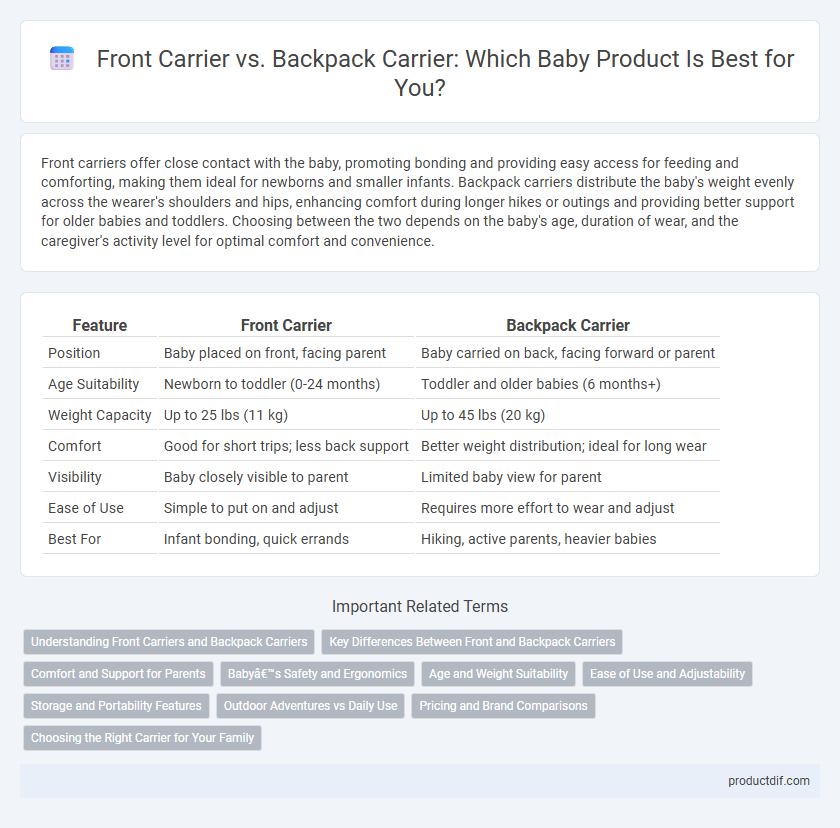Front carriers offer close contact with the baby, promoting bonding and providing easy access for feeding and comforting, making them ideal for newborns and smaller infants. Backpack carriers distribute the baby's weight evenly across the wearer's shoulders and hips, enhancing comfort during longer hikes or outings and providing better support for older babies and toddlers. Choosing between the two depends on the baby's age, duration of wear, and the caregiver's activity level for optimal comfort and convenience.
Table of Comparison
| Feature | Front Carrier | Backpack Carrier |
|---|---|---|
| Position | Baby placed on front, facing parent | Baby carried on back, facing forward or parent |
| Age Suitability | Newborn to toddler (0-24 months) | Toddler and older babies (6 months+) |
| Weight Capacity | Up to 25 lbs (11 kg) | Up to 45 lbs (20 kg) |
| Comfort | Good for short trips; less back support | Better weight distribution; ideal for long wear |
| Visibility | Baby closely visible to parent | Limited baby view for parent |
| Ease of Use | Simple to put on and adjust | Requires more effort to wear and adjust |
| Best For | Infant bonding, quick errands | Hiking, active parents, heavier babies |
Understanding Front Carriers and Backpack Carriers
Front carriers provide close contact for newborns and infants, promoting bonding and allowing easy monitoring of the baby's comfort and positioning. Backpack carriers are designed for older babies and toddlers, distributing weight evenly across the hips and shoulders to reduce strain during longer outings or hikes. Choosing between front and backpack carriers depends on the baby's age, developmental needs, and the caregiver's activity level.
Key Differences Between Front and Backpack Carriers
Front carriers provide close physical contact, allowing parents to easily soothe and monitor their baby, while offering better support for newborns and infants. Backpack carriers are designed for older babies and toddlers, distributing weight evenly across the hips and shoulders to reduce strain during longer periods of use. Key differences include age suitability, ergonomic support, and the level of interaction between parent and child.
Comfort and Support for Parents
Front carriers offer ergonomic support that evenly distributes baby weight across the parent's shoulders and hips, reducing strain during shorter outings. Backpack carriers provide enhanced comfort for longer hikes by incorporating padded shoulder straps and waist belts that alleviate lower back pressure. Choosing between the two depends on activity duration and the importance of lumbar support for the parent.
Baby’s Safety and Ergonomics
Front carriers offer enhanced head and neck support, ideal for newborns requiring close contact and optimal safety during early development. Backpack carriers distribute baby's weight evenly across the wearer's hips and shoulders, promoting better posture and ergonomic comfort for older infants during extended use. Selecting a carrier with adjustable straps and padded support ensures both baby safety and ergonomic benefits, reducing strain for caregiver and child alike.
Age and Weight Suitability
Front carriers are typically designed for newborns and infants up to 15 kg, providing close contact and support for babies from birth to around 12 months. Backpack carriers accommodate older babies and toddlers, often supporting weights from 7 kg to 20 kg, making them suitable for children aged 6 months to 3 years. Weight distribution in backpack carriers offers enhanced comfort for longer outings, while front carriers prioritize ergonomic support for younger infants.
Ease of Use and Adjustability
Front carriers offer quick, intuitive use with simple buckles and minimal adjustments, ideal for newborns and short trips. Backpack carriers provide advanced adjustability, supporting heavier loads and extended wear but require more time to secure properly. Selecting between the two depends on balancing ease of use with customization for comfort during prolonged use.
Storage and Portability Features
Front carriers typically offer limited storage, featuring small pockets mainly designed for essentials like keys or a pacifier, making them highly portable and easy to wear for quick errands. Backpack carriers often include larger, multi-compartment storage spaces suitable for diapers, bottles, and snacks, enhancing convenience for extended trips but adding some bulk when carrying. Portability favors front carriers due to their lightweight and compact design, while backpack carriers provide superior storage solutions at the cost of size and weight.
Outdoor Adventures vs Daily Use
Front carriers provide close contact and better support for infants, making them ideal for daily use and quick errands around town, while backpack carriers offer superior comfort and weight distribution for parents during prolonged outdoor adventures or hiking. Backpack carriers typically feature additional storage compartments and sunshades, enhancing convenience and protection in more rugged environments. Choosing between front and backpack carriers depends on balancing ease of access and intimacy with durability and ergonomic support for extended wear.
Pricing and Brand Comparisons
Front carriers typically range from $40 to $150, with popular brands like Ergobaby and BabyBjorn offering mid to high-end models known for ergonomic designs. Backpack carriers, often priced between $100 and $250, feature brands such as Osprey and Deuter that emphasize outdoor durability and comfort for longer carrying periods. Choosing between the two depends on budget and specific brand preferences, as front carriers generally target everyday use while backpack carriers suit active, outdoor lifestyles.
Choosing the Right Carrier for Your Family
Choosing the right baby carrier depends on comfort, lifestyle, and age of the child; front carriers provide close contact for newborns and promote bonding, while backpack carriers offer better weight distribution and are ideal for older babies or toddlers. Front carriers typically support infant head and neck stability, whereas backpack carriers allow parents to carry heavier children over longer distances with ergonomic benefits. Evaluating your daily activities, baby's developmental stage, and ease of use will help you select the best carrier suited for your family's needs.
Front Carrier vs Backpack Carrier Infographic

 productdif.com
productdif.com